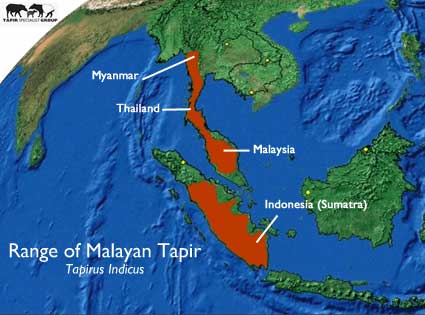In the heart of Southeast Asia's lush, tropical forests resides a creature that defies conventional classifications. The Malayan Tapir, despite its semblance to a pig, stands distinct as an odd-toed ungulate, sharing its lineage with the likes of rhinoceroses and horses.
What sets this elusive mammal apart, besides its peculiar ancestry, is its striking black and white coat. Evolving as nature's ingenious camouflage, this unique coloration splinters the outline of its body amidst the shadows of its forest habitat. As it navigates the dense foliage, the Malayan Tapir remains an enigmatic figure, hidden in plain sight.

One of its most remarkable features is its elongated, fleshy nose trunk—a remarkable adaptation that transcends mere aesthetics. This versatile appendage serves as both a tool for foraging and a survival mechanism. With unparalleled dexterity, the tapir utilizes its nose trunk to grasp foliage, deftly maneuvering leaves into its mouth. When submerged, it doubles as a snorkel, aiding its underwater excursions. A skilled swimmer and diver, it gracefully treads the riverbeds, a testament to its adaptability.\

Yet, despite these remarkable attributes, the Malayan Tapir is a creature of seclusion. Its shy disposition relegates it to the secluded interiors of its forest domain, making chance encounters a rarity for those who seek its presence. Human disturbance prompts its retreat into the depths of the forest, evading even the most determined observers.
Compounding its mystery is its nocturnal lifestyle. With a vision that falters both on land and underwater, the tapir relies heavily on its acute hearing and olfactory senses to navigate its surroundings. However, this very adaptation makes survival a precarious dance, especially under the cover of darkness.
The fate of the Malayan Tapir hangs precariously in the balance, marked as "Endangered" on the IUCN Red List. Its dwindling population—numbering fewer than 400-500 individuals in Sumatra—is a stark reminder of the peril it faces. The relentless encroachment of deforestation looms as the primary threat, eroding its natural habitat and pushing this enigmatic species closer to the brink of extinction.
Efforts to preserve this unique creature demand urgent attention. Conservation initiatives, coupled with awareness about the tapir's plight, stand as beacons of hope in the battle against its decline. Only through concerted action and unwavering dedication can we ensure the Malayan Tapir continues to grace the vibrant landscapes of Southeast Asia's forests, safeguarding a living testament to nature's diverse wonders.



















